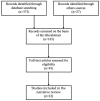The Role of Cisternostomy and Cisternal Drainage in the Treatment of Aneurysmal Subarachnoid Hemorrhage: A Comprehensive Review
- PMID: 38002540
- PMCID: PMC10670052
- DOI: 10.3390/brainsci13111580
The Role of Cisternostomy and Cisternal Drainage in the Treatment of Aneurysmal Subarachnoid Hemorrhage: A Comprehensive Review
Abstract
Aneurysmal subarachnoid hemorrhage (aSAH) provokes a cascade reaction that is responsible for early and delayed brain injuries mediated by intracranial hypertension, hydrocephalus, cerebral vasospasm (CV), and delayed cerebral ischemia (DCI), which result in increased morbidity and mortality. During open microsurgical repair, cisternal access is achieved essentially to gain proximal vascular control and aneurysm exposition. Cisternostomy also allows brain relaxation, removal of cisternal clots, and restoration of the CSF dynamics through the communication between the anterior and posterior circulation cisterns and the ventricular system, with the opening of the Membrane of Liliequist and lamina terminalis, respectively. Continuous postoperative CSF drainage through a cisternal drain (CD) is a valuable option for treating acute hydrocephalus and intracranial hypertension. Moreover, it efficiently removes the blood and toxic degradation products, with a potential benefit on CV, DCI, and shunt-dependent hydrocephalus. Finally, the CD is an effective pathway to administer vasoactive, fibrinolytic, and anti-oxidant agents and shows promising results in decreasing CV and DCI rates while minimizing systemic effects. We performed a comprehensive review to establish the adjuvant role of cisternostomy and CD performed in cases of direct surgical repair for ruptured intracranial aneurysms and their role in the prevention and treatment of aSAH complications.
Keywords: aneurysmal subarachnoid hemorrhage; cerebral vasospasm; cisternal drain; cisternostomy; delayed cerebral ischemia; hydrocephalus; ruptured aneurysm; vascular neurosurgery.
Conflict of interest statement
The authors declare no conflict of interest.
Figures



References
-
- Hoh B.L., Ko N.U., Amin-Hanjani S., Chou S.H.-Y., Cruz-Flores S., Dangayach N.S., Derdeyn C.P., Du R., Hänggi D., Hetts S.W., et al. 2023 Guideline for the Management of Patients with Aneurysmal Subarachnoid Hemorrhage: A Guideline From the American Heart Association/American Stroke Association. Stroke. 2023;54:E314–E370. doi: 10.1161/STR.0000000000000436. - DOI - PubMed
Publication types
LinkOut - more resources
Full Text Sources

